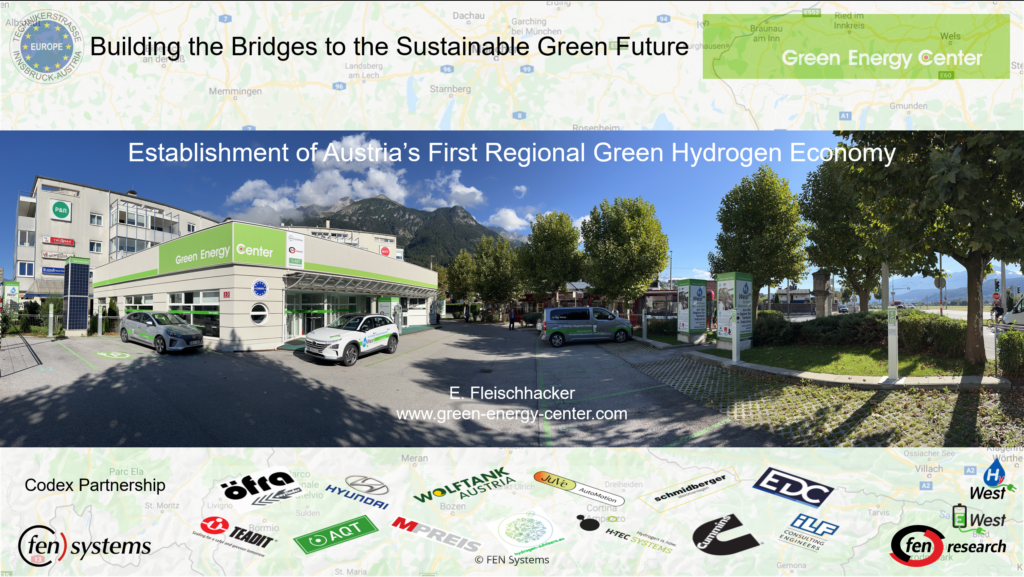Establishment of a sustainable green hydrogen economy in Central Europe was presented by Ernst Fleischhacker at the Austrian Energy Day in Vienna on 28th of September 2023 and is available in the free eBook entitled “A Guide to Austrian Energy Sector”.
Introduction
In this section, the focus is on the endeavors to establish a sustainable green hydrogen economy in Central Europe. The primary aim is to harness hydrogen as a solution to mitigate the uncertainties of renewable energy sources and reduce dependency on traditional energy resources.
Challenges Posed by Fluctuating Resources
It is important to highlight the significant challenges posed by fluctuating resources such as wind and solar power. These resources exhibit unpredictability in energy production, necessitating the need for effective management and optimization of energy processes to ensure stability and reliability.
Navigating the Power on Demand Process
Central to the discussion is the – so defined – “power on demand process.” Its central goal is to tackle the inherent variability in energy demand and supply. A key component of this process involves managing the operation of electric car charging with a simple photovoltaic tower. In principle this is able to ensure the mobility of one Battery Electric Vehicle (BEV) in a year. It is demonstrated that these stations can function only when the demand aligns with the availability of resources, making precise timing crucial.
Hydrogen as a Vital Solution
Hydrogen emerges as a pivotal solution for bridging the gap between fluctuating energy demand and supply. Through the utilization of electricity from renewable sources and water, hydrogen production serves as an effective means of storing surplus energy generated during the summer to meet heightened demand in the winter.
Regional Energy Autonomy Strategy
The region’s strategic vision for achieving energy autonomy by 2050 is the focus of work being carried out in Central Europe. This strategy encompasses a multifaceted approach, including a substantial reduction of energy demand by 50 % and a comprehensive transition towards cleaner energy resources and systems , with a strong emphasis on transforming the transportation sector.
European Union’s Commitment to Hydrogen
The European Union underscores its dedication to green hydrogen through its strategic plans. These encompass scaling up electrolyser capacity to the gigawatts scale by 2050, reflecting a steadfast commitment to a sustainable energy future.
Localized Green Hydrogen Initiatives
Several noteworthy green hydrogen projects have already been implemented in the region by the private economic initiative of the Green Energy Center Europe in Innsbruck. These include the establishment of the first fuel cell electric vehicles (FCEVs) in Europe, hydrogen refueling stations, the construction of the first green hydrogen production and logistic center in central Europe, the development of an energy – autonomous public transport systems, and the establishment of innovative power-to-x projects that efficiently convert surplus electricity into hydrogen or other valuable commodities.
The Vital Role of Redundancy
The creation of redundancy among these diverse projects proves instrumental in ensuring the resilience and stability of the regional green hydrogen economy.
Constructing the Infrastructure Backbone
A significant project presented here aims to establish a robust logistical network for hydrogen distribution. This encompasses the development of a 50 MW electrolysis plant and the integration of gas grid injection, marking a substantial stride in building the backbone of the green hydrogen economy.
Overcoming Challenges through Fair Funding
The realization of green hydrogen infrastructure projects hinges on securing adequate public funding support. It is important to note the equitable funding conditions which enable hydrogen solutions – for instance FCEVs – the same conditions as battery- powered vehicles, to facilitate the successful execution of these private economic initiatives.
Conclusion
This section underscores the unwavering commitment of a private economic initiative for establishing a sustainable regional green hydrogen economy. This commitment is further supported by strategies aimed at addressing the challenges posed by fluctuating renewable resources, implementing a comprehensive regional plan, and establishing a robust logistical framework for hydrogen distribution and application. These efforts resonate with the European Union’s vision of a greener energy future.
© Montel Group / FEN Sustain Systems GmbH

Hydrogen Forum Discussion

v.l.n.r: Michaela Leonhardt, Ernst Fleischhacker, Carola Millgramm, Boris Šešlija
Overall Programm

15:50 – 16:05 Hydrogen – what is the suitable regulatory framework?
Carola Millgramm, Head of Gas Department, E-Control
16:05 – 16:20 Establishment of Austria’s First Regional Green Hydrogen Economy
Ernst Fleischhacker, Chairman of the Green Energy Center Europe, CEO FEN Sustain Systems GmbH
16:20 – 16:30 Large-Scale Green Hydrogen Production from PowerPoint to Realisation – Pannonian Green Hydrogen
Michaela Leonhardt, Head of Green Hydrogen, Burgenland Energie
16:30 – 16:55 Hydrogen forum discussion
Michaela Leonhardt, Head of Green Hydrogen, Burgenland Energie
Carola Millgramm, Head of Gas Department, E-Control
Ernst Fleischhacker, Chairman of the Green Energy Center Europe, CEO FEN Sustain Systems GmbH
Boris Šešlija, Commodity Expert, Wien Energie